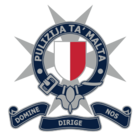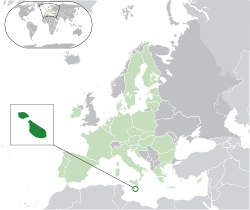
Malta Police Force

This article needs additional citations for verification. (December 2019) |
| Malta Police Il-Korp tal-Pulizija ta’ Malta | |
|---|---|
 Malta Police Force Logo | |
 Official Insignia | |
 Flag of the Malta Police Force | |
| Common name | Il-Pulizija |
| Motto | Domine Dirige Nos Lord Guide Us |
| Agency overview | |
| Formed | 12 July 1814 |
| Annual budget | €76,480,000 (2020)[1] |
| Jurisdictional structure | |
| National agency (Operations jurisdiction) | Malta |
| Operations jurisdiction | Malta |
 | |
| Map of Malta Police's jurisdiction | |
| Size | 316 km² |
| Population | 475,700[2] |
| Legal jurisdiction | As per operations jurisdiction |
| Constituting instrument |
|
| General nature | |
| Operational structure | |
| Headquarters | Police General Headquarters, Pjazza San Kalcidonju, Floriana FRN 1530, Malta |
| Police Officers | 2.400 (2020) |
| Civilians | 102 (2018) |
| Minister responsible |
|
| Agency executive |
|
| Parent agency | Ministry for Home Affairs, Security, Reforms & Equality |
| Notables | |
| Anniversary |
|
| Website | |
| pulizija | |
| Emergency Telephone Number 112 Crime Stop Line 119 | |
The Malta Police Force (Maltese: Il-Korp tal-Pulizija ta’ Malta) is the national police force of the Republic of Malta. It falls under the responsibility of the Ministry for Home Affairs, Security, Reforms & Equality and its objectives are set out in The Police Act, Chapter 164[3] of the Laws of Malta.

As of 2020, the force is made up of around 2,400 members.

Organisation
The duty of the executive police is to preserve public order and peace, to prevent and to detect and investigate offences, to collect evidence and to bring the offenders, whether principals or accomplices, before the judicial authorities.


Specialised Branches:[4]

- Anti-Money Laundering
- Community Policing
- Counter Terrorism Unit (CTU)
- Criminal Intelligence & Analysis Unit (CIAU)
- Cyber Crime Unit (CCU)
- Domestic Violence Unit (DSQ)
- Drugs Squad (DSQ)
- Economic Crimes
- Environment Protection Unit (EPU)
- Gender-Based & Domestic Violence (GBDV)
- Homicide
- Immigration
- International Relations Unit (IRU)
- K9 Section
- Major Crimes (CID)
- Mounted Section
- Rapid Intervention Unit (RIU)
- Special Intervention Unit (SIU)
- Stolen Vehicle Squad (SVS)
- Traffic
- Vice Squad (VSQ)
- Victim Support Unit (VSU)

Ranks
| Insignia[5][6] | Name | English |
|---|---|---|

|
Kummisarju | Commissioner of police |
| Deputat Kummisarju | Deputy commissioner | |

|
Assistent Kummisarju | Assistant commissioner |

|
Supretendent | Superintendent |
| Spettur | Inspector | |

|
Surġent Maġġur I | Sergeant major I |

|
Surġent Maġġur II | Sergeant major II |

|
Surġent | Police sergeant |

|
Kuntisstabli | Police constable |
History
The Malta Police Force is one of the oldest police forces in Europe. In its present form, it dates from a proclamation during the governorship of Sir Thomas Maitland (1813–1814). When Malta became a crown colony of the United Kingdom by the Treaty of Paris, Maitland was appointed Governor and commander-in-chief of Malta and its dependencies by the Prince Regent's Commission of 23 July 1813. On his appointment Maitland, embarked on many far reaching reforms, including the maintenance of law and order.[7]

By Proclamation XXII of 1 July 1814, Maitland ordered and directed that all powers up to then exercised with respect to the administration of the police of the island of Malta and its dependencies were to be administered by the authorities under established procedures, after 12 July 1814.[7]


The police was to be divided into two distinct departments – the executive police and the judicial. The inspector general of police (nowadays the commissioner of police) was to be the head of the executive police, and received orders from the governor. The magistrates of police for Malta and for Gozo were to be the heads of the judicial police.[7]

After the grant of self-government in 1921, the police department became the responsibility of the Maltese government. The first minister appointed, who was responsible for justice and the police, was Dr Alfredo Caruana Gatto.[7]

General headquarters
The Police Depot, as it is known today, was built by the Portuguese Grand Master Manoel De Vilhena in 1734 and at first it served as an institute called Casa D’Industria, a home for homeless women. They were taught basic skills and education such as reading, writing and some trades like weaving, carding and processing cotton.

In 1850, during the British occupation period, this building was used as the General Hospital. Beneath this building, a shelter was dug at the beginning of the Second World War in order to tend to wounded patients who could not be easily moved from one place to another. This space therefore provided a safer environment for patients during air bombardments. This is not only the only shelter in the Maltese Islands used for this function. There is no known underground hospital on the continent that was built or dug out to operate in this way.

It was in 1954 that the Police Force moved into this building and turned it into its General Headquarters, from where it still operates today.[8]

Police museum
The museum is divided into two sections: each section is housed in a separate hall. The first section deals with the administrative history of the force and the second part is about some of the criminal cases.

In the first hall, one will see various objects and belongings, for example uniforms, badges, medals, decorations, weapons and many other interesting things including tools and vehicles which were all required and used in different periods which helped the Police Force to carry out its duty to the best of its ability.

In the second hall one can see made-up scenes of crime that happened in Malta.[8]

Police commissioners
- Col Francesco Rivarola (1814–1822)
- Lt Col Henry Balneavis (1822–1832)
- Charles Godfrey (1832–1844)
- Frederick Sedley (1845–1858)
- Hector Zimelli (1858–1869)
- Raffaele Bonello (1869–1880)
- Col Attillo Sceberras (1880–1884)
- Capt. Richard Casolani, RMFA (1884–1888)
- Melitone Caruana (1888–1890)
- Comm. Hon. Clement La Primaudaye, MVO., RN (1890–1903)
- Tancred Curmi (1903–1915)
- Claude W. Duncan (1916–1919)
- Col Henry W. Bamford, OBE (1919–1922)
- Antonio Busuttil (1922–1923)
- Mjr Frank Stivala (1923–1928)
- Captain Salvatore Galea (1928–1939)
- Lt Col Gustavus S. Brander, OBE (1930–1932)
- Joseph Axisa (1939–1947)
- Joseph Ullo (1947–1951)
- Herbert Grech (1951–1954)
- George Cachia, L.P. (1954–1956)
- Vivian Byres de Gray, MVO., MBE., BEM (1956–1971)
- Comm. Alfred J. Bencini (1971–1973)
- Edward Bencini (1973–1974)
- Enoch Tonna (1974–1977)
- John N. Cachia (1977–1980)
- Dr Lawrence Pullicino, LL.D. (1980–1987)
- Bgdr. John Spiteri, AFM (1987–1988)
- Alfred A. Calleja (1988-1992)
- George Grech (1992–2001)
- John Rizzo (2001–2013)
- Peter Paul Zammit, L.P. (2013–2014)
- Michael Cassar (2014–2016)
- Lawrence Cutajar (2016–2020)
- Angelo Gafa (2020–)
References
- ^ "The Budget Speech 2020" (PDF). mfin.gov.mt.
- ^ "Eurostat: Population on 1 January" (PDF). Eurostat. 14 June 2018.
- ^ Police Act, 2017 (Act No. XVIII of 2017) (Act XVIII). 2017.
- ^ "Organisational Chart". pulizija.gov.mt. Retrieved 27 September 2020.
- ^ "Police Force Ranks". pulizija.gov.mt. The Malta Police Force. Retrieved 10 March 2020.
- ^ "Police Force Ranks". homeaffairs.gov.mt. Post of First Class Sergeant - Major in the Malta Police Force. 10 May 2019. Retrieved 5 February 2022.
- ^ a b c d "History of the Malta Police". pulizija.gov.mt. Retrieved 18 September 2018.
- ^ a b "Police Museum". pulizija.gov.mt. Retrieved 18 September 2018.
External links
See what we do next...
OR
By submitting your email or phone number, you're giving mschf permission to send you email and/or recurring marketing texts. Data rates may apply. Text stop to cancel, help for help.
Success: You're subscribed now !
